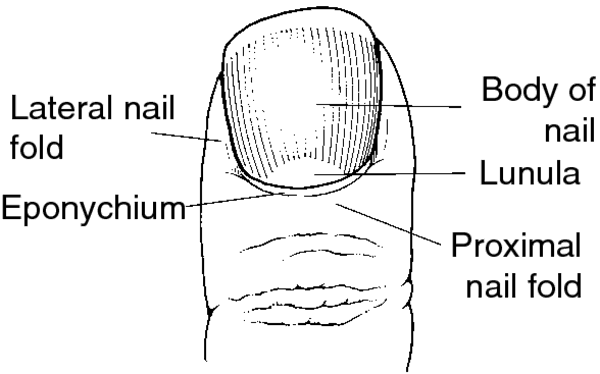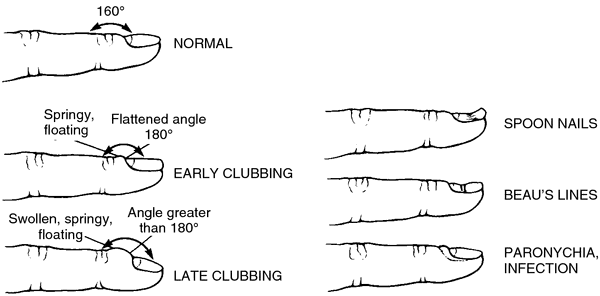Medical term:
unguis
nail
[nāl]1. a rod of metal, bone, or other material used for fixation of the ends of fractured bones.
2. a hardened or horny cutaneous plate overlying the dorsal surface of the distal end of a finger or toe. The nails are part of the outer layer of the skin and are composed of hard tissue formed of keratin. Called also unguis.


Parts of the nail. From Dorland's, 2000.

Nail abnormalities. From Lammon et al., 1996.
ingrown nail see ingrown nail.
spoon nail a nail with a concave surface.
Miller-Keane Encyclopedia and Dictionary of Medicine, Nursing, and Allied Health, Seventh Edition. © 2003 by Saunders, an imprint of Elsevier, Inc. All rights reserved.
nail
(nāl),1. One of the thin, horny, translucent plates covering the dorsal surface of the distal end of each terminal phalanx of fingers and toes. A nail consists of corpus or body, the visible part, and radix or root at the proximal end concealed under a fold of skin. The underpart of the nail is formed from the stratum germinativum of the epidermis, the free surface from the stratum lucidum, and the thin cuticular fold overlapping the lunula representing the stratum corneum. Synonym(s): unguis [TA], nail plate, onyx
2. A rod of metal or other solid substance, used in operations to fasten together the fragments of a broken bone.
[A.S. naegel]
Farlex Partner Medical Dictionary © Farlex 2012
unguis
(ŭng′gwĭs)n. pl. un·gues (-gwēz)
Zoology A nail, claw, or hoof.
The American Heritage® Medical Dictionary Copyright © 2007, 2004 by Houghton Mifflin Company. Published by Houghton Mifflin Company. All rights reserved.
nail
(nāl)1. One of the thin, horny, translucent plates covering the dorsal surface of the distal end of each terminal phalanx of fingers and toes. A nail consists of a visible corpus or body, and a radix or root at the proximal end concealed under a fold of skin. The under part of the nail is formed from the stratum germinativum of the epidermis, and the free surface from the stratum lucidum, with the thin cuticular fold that overlaps the lunula representing the stratum corneum.
2. A slender rod of metal, bone, or other solid substance, used in operations to fasten together the divided extremities of a broken bone.
Synonym(s): unguis [TA] , nail plate, onyx.
Synonym(s): unguis [TA] , nail plate, onyx.
Medical Dictionary for the Health Professions and Nursing © Farlex 2012
unguis
- a claw or nail.
- the tip of the arachnid chelicera through which opens the poison gland.
- a stalk present on some flower petals.
Collins Dictionary of Biology, 3rd ed. © W. G. Hale, V. A. Saunders, J. P. Margham 2005
Patient discussion about unguis
Q. My nails are black- is it dangerous? Hi, I was diagnosed with colon cancer and now I receive chemotherapy. This morning I found that my nails are brown and blue, and other nails have white lines on them. Is that dangerous? Should go and see a doctor?
A. The chemo can cause several changes in your nail, e.g. make them brittle etc. You can find some more info at : http://www.breastcancer.org/tips/hair_skin_nails/nails.jsp
Q. my guy friend has a very sick looking toe nail, what should he do? its really thick and has ridges, its also dark yellow and it looks to me has thick toe jam too... ugh, he needs your help please!
A. It sounds like Toenail fungus. Symptoms of toenail fungus, which can be caused by several types of fungi, include swelling, yellowing, thickening or crumbling of the nail, streaks or spots down the side of the nail, and even complete loss of the nail. Toenail color can vary from brown or yellow to white with this condition. I suggest your friend goes to see a foot doctor. The doctor might remove as much of the nail as possible by trimming, filing or dissolving it. Medicated nail polish might be prescribed for a localized infection, but a serious infection will likely be treated with a prescription oral antifungal medication. Only in severe cases will surgical removal of the nail be recommended.
Q. what natural cure for toe nail fungus really works?
A. Haven't heard about anything natural that was actually provent in reliable, well controlled trial. Especially since natural medications usually aren't tested in this way, I'm not sure there can be an accurate and true answer for this question.
More discussions about unguisThis content is provided by iMedix and is subject to iMedix Terms. The Questions and Answers are not endorsed or recommended and are made available by patients, not doctors.
Latest Searches:
antimitotic - antimetabolites - antilogous - antileishmanial - antihelmintic - antifibrotic - antiendotoxin - anticoagulative - anticoagulant - anticholelithogenic - antiasthmatics - antianxiety - antiantibody - anthropical - anthraquinone - anteorbital - Anorgasmy - anociassociation - ankerite - anitrogenous -
- Service manuals - MBI Corp